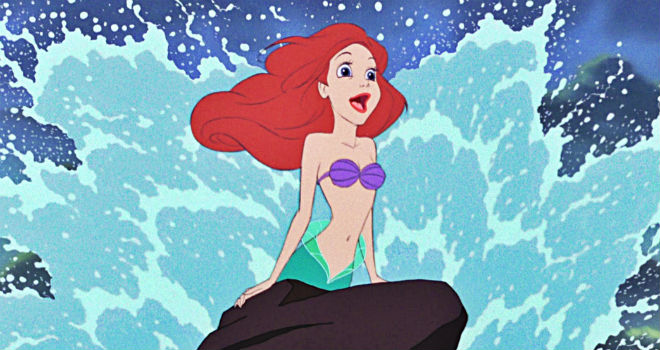
Hard to imagine, but there was a time, before the release of “The Little Mermaid,” when even Disney’s own studio chief didn’t expect much from the movie because it was a “girl’s film.” But Jeffrey Katzenberg was happy to be proved wrong when the film was released 25 years ago this week (on November 17, 1989).
“The Little Mermaid” was not only an enormous critical and commercial success, but it also launched a creative renaissance in Disney’s animated features (including such modern classics as “Beauty and the Beast” and “The Lion King“) and a wave of princess-mania that continues to this day.
Still, as many times as you or your kids have watched “Little Mermaid” (probably many, many, many times), there’s a lot you may not know about it, including who almost starred in it, who the characters were drawn to look like, and what was really up with that scene of the bishop with the bulging pants.
Here, then, are 25 “Little Mermaid” secrets that won’t even cost you a fin.
1. Walt Disney had initially considered adapting Hans Christian Andersen’s fairy tale back in the 1930s, as a follow-up to “Snow White and the Seven Dwarfs” and other fairy-tale cartoon features.
2. Illustrator Kay Nielsen even worked up some character sketches for the movie before the project was shelved. Decades later, the “Little Mermaid” animators rediscovered his sketches in the Disney archives and used them as inspiration for their own character work. He earned a credit in the final film, nearly 50 years after he did the work.
3. Disney animation director Ron Clements revived the idea in the 1980s, but then-studio chief Jeffrey Katzenberg initially turned down the idea because the studio was hoping to develop a sequel to its live-action mermaid hit, “Splash,” and he thought the project would be too similar. But he changed his mind the next day and greenlit the movie.
4, Off-Broadway lyricist Howard Ashman (“Little Shop of Horrors”), who’d been hired to do a song for Disney’s “Oliver & Company,” took a look at the story outline for “Little Mermaid” and suggested changing a minor English butler character into a Jamaican crab. This led to the calypso song “Under the Sea” and changed the entire nature of the production. It soon became a Broadway-style musical, with an entire song score by Ashman and his composing partner, Alan Menken, and the hiring of Broadway actors to sing the primary character parts.
5. In designing heroine Ariel, the animators were inspired by the body of Alyssa Milano (then starring on “Who’s the Boss?”) and the hair of astronaut Sally Ride (that is, the way it waved as she traveled in zero gravity). Animator Glen Keane joked that the character was drawn to resemble his own wife, whom he said looked just like Ariel, only “without the fins.”
6. For the role of Ariel, Ashman recommended Jodi Benson, who had starred in his short-lived musical based on the 1975 movie “Smile,” a satire of small-town beauty pageants. (One of Ashman’s songs for Benson in the show had been a number called “Disneyland.”) Benson had also starred in a Broadway musical called “Welcome to the Club” alongside Samuel E. Wright, who would play Sebastian the Crab in “Mermaid.”
7. Christopher Daniel Barnes was just 16 when he voiced Prince Eric in “Mermaid.” He went on to voice various princes in straight-to-video Disney movies, but he’s best known to live-action audiences for playing Greg Brady in the mid-’90s “Brady Bunch” feature films.
8. The villain Ursula was designed to look like Divine, the drag queen best known for his starring roles in John Waters films, from “Pink Flamingos” to “Hairspray.”
9. Initially, the filmmakers wanted “Golden Girls” star Bea Arthur to play Ursula, but she turned the part down. Others considered included Roseanne Barr, Nancy Marchand, Charlotte Rae, and Nancy Wilson, until Elaine Stritch was cast. But she proved incompatible with Ashman and Menken’s song styles, so she was replaced by Pat Carroll.
10. Patrick Stewart was reportedly offered the role of King Triton, but he had to turn it down because he was too busy with “Star Trek: The Next Generation.” The part went instead to Kenneth Mars.
11. “The Little Mermaid” was, in many ways, a throwback to the kind of animated features the studio hadn’t made since Walt’s time. Not only was it a musical, but it was also Disney’s first fairy-tale adaptation since “Sleeping Beauty” in 1959. Animators also returned to the old technique of having the voice actors film their performances and then drawing the characters based on their body movements. (Ariel’s actions were modeled on film in part by Sherri Stoner, who would go on to perform similar duties for Belle in “Beauty and the Beast.”) They even took out of mothballs Disney’s massive old multiplane camera, responsible for the illusion of depth in the studio’s classic animated features, but the machine was in such poor condition that they had to farm out the multiplane work to an outside animation house.
12. The special effects needed for the underwater sequences were among the most complex for any Disney animated feature since “Fantasia” 50 years earlier. Animator Mark Dindal estimated that he and his colleagues had to draw a million bubbles.
13. As it turned out, “The Little Mermaid” was the last Disney feature to use traditional hand-painted cel animation. Almost all of the film was hand-painted except for the final wedding sequence, which was Disney’s first use of a computer-assisted production system, one that digitally scanned the animators’ drawings and inked and colored them. The system was designed by Pixar, marking Disney’s first collaboration with the computer-animation company that would become Disney’s in-house developer of beloved CGI cartoon features.
14. Katzenberg nearly cut Ariel’s yearning ballad “Part of Your World” from the film when kids attending a rough-cut screening grew fidgety. The filmmakers reminded him that MGM nearly made the same mistake when it had threatened to cut the slow-moving “Over the Rainbow” from “The Wizard of Oz.” Viewers responded better to the song during a screening with more complete animation, and the number stayed.
15. Benson reportedly recorded the song in the dark, in order to simulate the feeling of being underwater.
16. Katzenberg eventually grew so confident about the film that he predicted it would be the first animated feature to gross $100 million at the domestic box office. The studio spent $40 million making “Mermaid,” a then-unheard-of sum for an animated feature. It made back $84 million in North America — just $16 million shy of Katzenberg’s prediction — and another $100 million overseas.
17. Accompanying the initial theatrical release was “A Grand Day Out,” the first clay-animation short to star Wallace and Gromit.
18. The film was nominated for three Oscars, all for its music. Menken won for Best Score, and he and Ashman landed two Best Song nods, for “Under the Sea” (which won) and “Kiss the Girl.” They were Disney’s first Oscars for an animated feature since “Song of the South” 42 years earlier. “Mermaid’s” Oscar success launched a new wave of Academy Awards for songs from Disney cartoons.
19. At the time, Disney had resisted making its animated features readily available on home video, fearing it would cut into profits from its then-standard practice of re-releasing them theatrically every seven years. Nonetheless, “Little Mermaid” came out on VHS in May 1990, just 6 months after the film’s initial theatrical release. It ultimately sold 23 million copies on VHS and another 7 million on DVD years later, making it one of the most successful home video releases of all time.
20. The film did return to theaters for an eighth anniversary re-release in November 1997. (Disney pointedly opened it on the same day that rival studio Fox issued a new movie by former Disney animator Don Bluth, “Anastasia.”) “Mermaid” sold another $27 million in tickets.
21. Menken and Ashman went on to compose songs for Disney’s “Beauty and the Beast” and “Aladdin.” Ashman died of AIDS during the production of “Aladdin,” and the rest of the songs were completed by lyricist Tim Rice, of “Evita” and “Jesus Christ Superstar” fame. Menken went on to compose scores for Disney cartoon features, from “Pocahontas” to “Tangled.”
22. A Broadway musical version of “Mermaid” opened in New York in 2008. Menken and lyricist Glenn Slater composed some new songs for the play.
23. Disney scrapped plans for a 3D re-release of “Mermaid” after doing lackluster business with other retrofitted 3D cartoon features. It did release the 3D version on disc and at one theater, the El Capitan in Hollywood, in late 2013.
24. Disney did try one more innovation with the film’s 2013 theatrical re-release Called “Second Screen Live,” it encouraged kids to bring their tablets and smartphones to deliver “Little Mermaid”-related content during the screenings.
25. For years, sharp-eyed viewers have been mystified by the bishop in the first wedding sequence, whose tunic sports a suspicious bulge below the waist. If you watched especially closely, you could see that it was his knobby knee, and not his groin, that was sticking out. Still, smut-minded viewers insisted that they’d seen an erection; one even filed a lawsuit against Disney, for allegedly misrepresenting the G-rated movie as suitable for children. She later dropped the suit, but the offending protuberance has been airbrushed out of the Blu-ray release anyway.

 © 2024 Cheryl Clossick — Real Estate One. All Rights Reserved.
© 2024 Cheryl Clossick — Real Estate One. All Rights Reserved.